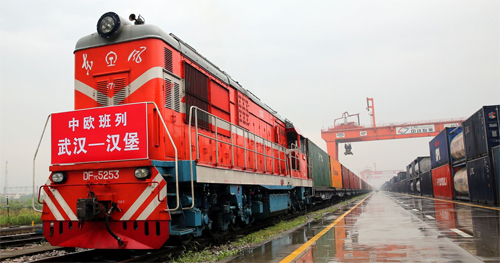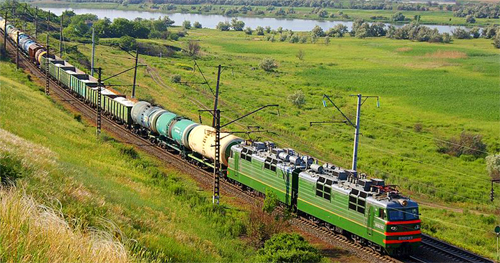I recently watched a short documentary on Bon Cloud explaining what happens once Cargo has left China and arrives in Hamburg in Germany. The short film discusses the transcontinental block train that runs from China to Hamburg transporting many electrical and general merchandise products.
A young trainee, Samir Turkovic, who works at the DUSS terminal in Hamburg is interviewed during the documentary and explains about the process, what his job entails and what it means to be a Crane operator bringing in all the Merchandise that is delivered from China to Europe. Samir is 21 years old and has been training at the terminal for three years. He is actually employed by China trains and in the opening scenes of the film he explains a little about himself (he likes to work hard and play hard!) and talks about the operations he carries out. He controls the crane that lifts up to around 200 containers that arrive into Hamburg.

The process of unloading the containers takes around two days. The block train is also commonly referred to as the modern silk road and is the longest freight train route in the world. It spreads across a distance of more than 10,000 km. My first opinion on the opening scenes was intrigue as I never even knew such a thing existed. I always believed that goods were imported into Europe from China via air or sea. I was amazed to discover this was not the case. So as a viewer, the subject matter grabbed my attention immediately which is so important when watching a short film or documentary.
I was also impressed to discover that the time of transportation is 20 days less than shipping by sea and is 80% cheaper than transporting via air. The cargo arrives in 12 – 15 days which is pretty quick, considering the distance spanned. Wow! The EU is one of China’s largest trading partners and so obviously finding cheap and quick solutions to bring in exported goods from China is important. While I was learning about a subject I knew nothing about, which I love to do by the way as I am fascinated with discovering new things in the world, I also enjoyed looking at the surrounding architecture and the cinematography, which by the way, was very good.
The transcontinental train route has created many jobs for young Germans who are trained in their skills as they work and earn. I love this idea. I myself live in Europe and finding ways to give young people career and job opportunities is something I am a firm believer in. Samir tells the viewers that he loves the fact when he orders something from the internet it arrives very quickly and he says that his favourite brands from China are Apple and Samsung. I can vouch for this as I have two teenage boys myself and they also love both these brands equally! He also comments on the facts that all the best electrical equipment such as cameras and T. V’s come from China. It’s great to see a member of the younger generation not only enjoying his work, being grateful for the job opportunity he has, but also fully supports the Country and their goods that he handles. He explains how grateful he is to China for bringing in a big initiative that helps the locals and the people of Europe in general.
Samir is actually an interesting young man as well. He tells the viewer that he loves to play computer games but operating the crane is cooler. My only complaint with his interview was the fact although he speaks English very well I found some of his words were a bit difficult to understand so from a viewer prospective I would have preferred subtitles on the film as well, just to help a little. But this in no way distracts from how enjoyable and educational the film itself is. One just has to pay close attention to what is being said.
The young man also says that his pay is very good so another brownie point for China there as well. Personally, I would have liked a bit more background information on the company and the train line itself. However, the short documentary engaged me enough that I wanted to discover more about it so I did a little bit of research.
I found out that the line was opened in 2014 and China has sent over 200 block trains to Hamburg. They received over 30,000 shipping containers and there are plans to increase this to 100,000 by 2020. What a great thing this will be as it will mean more jobs, more goods for Europe and another boom for Hamburg. I also discovered that the goods are transported with a higher success rate in which the goods are not damages as much as they can be when transporting by sea or air. This is great for the consumer.
There is also a transcontinental line from China to Spain which departs from Yiwu in Eastern China and passes through Kazakhstan, Russia, Belarus, Poland, Germany, France and finally Spain travelling a total of 16,000 miles. Its final destination in Spain is Madrid. The train transports 82 shipping containers mostly containing consumer goods and when it returns it takes back things such as olive oil, wine and cured ham.
Although the service is slower than the others to Germany and only operates twice a month, it saves 1/3 delivery time of block cargo, thus cash flow has been accelerated significantly and more deals have been achieved. Some people may worry about that goods have to be transferred to different wagons at three points during the trip because of incompatible track gauges and bureaucratic hurdles in different countries. But China and other countries along the routes have been trying to work together to make the customs clearance and other procedures more efficient. The same applies to the Spanish train line.

My only other small little niggle I also had about the film was the fact that I would have also liked to have seen one of the company owners interviewed in the film, simply for the fact that I would have liked to have heard what opinions they had regarding the success of the block train and what plans they may have for the future. For example, other lines that may be constructed or other terminals that may be opened along the routes already available.
I can thoroughly recommend this short little documentary. It’s interesting, educational and quite good fun to watch. So, a big thumb up from me. I hope you all enjoy it as much as I did.
Video for article:


